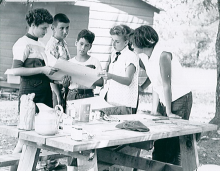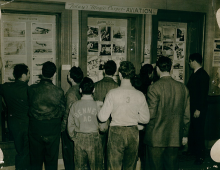Our History
Washington Heights has seen innumerable changes since 1917, but one thing has remained constant: The YM&YWHA of Washington Heights & Inwood (the Y) has been there to serve the needs of an ever-evolving community.




During wave after wave of immigration to the United States, Washington Heights and Inwood became hotspots for populations fleeing as refugees from wars, escaping oppressive regimes, and simply hoping for a better life for their families. In the Y’s earliest years of operation, the major focus was on the resettlement of refugees from WWI and WWII – in fact, the neighborhood became home to the most German refugees in the country in the 1930’s. Later, from 1978 onward, the Y worked to aid Jewish refugees from Russia with similar urgency.
To serve the needs of these communities, the Y has, from the beginning, taken the approach of evaluating the most pressing needs and figuring out how to meet them. For these vulnerable immigrant communities, the ability to assimilate was of the utmost importance, both logistically and psychologically. The Y therefore focused on English classes, citizenship tutoring, and recreation-based community building programs like choruses and youth sports to keep communities close through troubled times.
Today, many of the Y’s programs address similar needs for a new population of immigrants: those from the Dominican Republic. This once heavily Jewish neighborhood has now changed demographics, with an estimated 80% of residents claiming Dominican heritage; classes in citizenship and English language are accordingly now offered in Spanish, in an effort to match the new make-up of the neighborhood.
Serving at-risk communities is never an easy task; for the Y, it was more than once a struggle just to keep the doors open. The organization has moved twice before settling in its current location, and in the early 80’s battled the harsh realities of “white flight” ravaging the neighborhood. Executive Director Martin Englisher remembers the Y at this time being one of the few literal safe-havens in the neighborhood – while race riots filled the streets with fire, threats, and bodily violence, the Y fought for increased police presence, reconciliation between warring factions, and the continuation of vital services aimed at returning the neighborhood residence to some semblance of a normal life.
Having successfully survived the tumultuous 80’s, the 1990’s found the Y returning to expand programs that were an early focus of the organization: multi-generational programming and innovative care for the elderly. Jewish and Latino communities both tend toward a more holistic understanding of family, beyond the nuclear unit, and the Y seeks to improve the lives of young and old alike by bringing the whole community together. In 1990, the organization received funding to build the Wien House – a 100-unit independent living facility adjacent to the Y. Through this building and beloved programs like lunch for seniors and continuing education classes, seniors experience a marked improvement in quality of life; indeed, many feel life is more worth living within the Y’s vibrant, supportive community. Of the 100 original residents of Wien House, 8 remain alive and active to this day, 22 years later.
At the other end of the spectrum, the Y’s nursery school is likewise rapidly growing in popularity and attendance. The revitalization of the neighborhood, and its general aura of “authentic New York-ness” thanks to its parks, family businesses, and diversity, has resulted in a huge boom in services for young children. The nursery school has grown from an average of 2-3 classrooms to 7 fully staffed rooms, including 3 Universal Pre-Kindergarten and Dual Language classes. Our Nursery School staff emphasizes individual attention for each child while building a community of learners in a safe, nurturing, and academically enriching environment.
Our focus on community spreads to many programs at the Y, including our Sousa project where in 2009 we created a unique musical theater program for teens. For 4 years, a group of Jewish and Dominican students worked together to study the history of the Dominican Republic’s immigration policies prior to WWII, making the country one of few safe harbors for Jews lucky enough to escape Germany. These lessons were put to work as the students came together to work on an original performance, which has been featured at many notable venues, including the United Nations and now available on DVD. The project highlighted the unique mixture of cultures in the neighborhood, preserving the history of the Holocaust, and celebrating what we can achieve by working together, is a pillar of the Y’s work.
To sum up the services of the Y in a short history such as this would be impossible: from providing access to social services, to work with battered women, to mental health outreach, the community depends on the organization as a safety net. In many of these areas, the Y was a trailblazer, focusing on the psychological needs of the community long before such thinking was in vogue. Likewise, the Y was the first organization to open a day camp for neighborhood children in the 1930’s, providing recreation as well as much-needed relief for their mothers.
The YM&YWHA of Washington Heights & Inwood still works every day to meet the challenges of serving its community. Staff must be trained in cultural diversity, and services are offered in three languages (English, Spanish, and Russian). A heavy emphasis is placed on workforce development and providing good jobs for members of the neighborhood. The Y is determined to focus on the quality of the services it offers, not just quantity; today all the teachers it employs have at minimum a Master’s degree.
And there is always the challenge of maintaining the organization’s central Jewish identity while serving a diverse community. Of course, this means offering classes in Jewish life and providing a comfortable environment for the Jewish seniors of Wien House. But more than anything, the Y accomplishes this through its commitment to the concept of tikkun olam: repairing the world. The Y is constantly raising the bar for its own programs, asking how they can leave the neighborhood in a better state than it was. Through this outlook, the organization looks forward to many more years of service, and the associated rewards of working within a community determined to succeed together.

